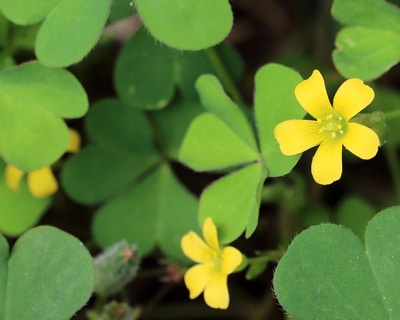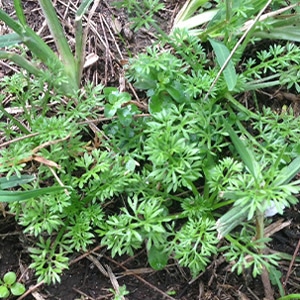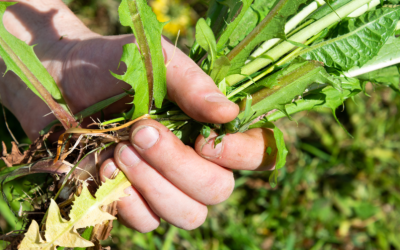Weed Out Those Winter Weeds
Weed Out Those Winter Weeds
If they haven’t already, those pesky winter weeds will start to pop up over the next few months. It’s important to treat them as quickly as possible to reduce stress on your lawn. However, in order to do so, you need to know what kind of weed it is. Below we’ll uncover some of the more common weeds for this time of year. Then, we’ll discuss how to get rid of them, or better yet, stop them from appearing in the first place.
The cold extremes of winter can be extremely tough for your lawn. As it won’t be getting enough sunlight, it’ll likely go into semi-hibernation. This preserves energy but slows growth, leaving weeds an opportunity to sprout. With less sunlight, your lawn will struggle to outcompete weeds, repair damage and grow as tightly as usual.
All of these factors mean that if you don’t take care of weeds as they pop up, your lawn could be overrun once spring arrives.
But how do those weeds get into your yard in the first place?
Weeds spread in a couple of ways, depending on what type of weed it is.
Seeds: Almost all types of weeds will seed at some point during their lifecycle. Most of the time these seeds will be brought into your lawn in the wind, on your clothing, your pet’s fur or in bird droppings. However, if a weed has been in your yard before and had the chance to seed, they could be hiding in your soil. Weed seeds can remain dormant in the soil for years, and in some cases, for decades. If you have the same weed reappearing each winter, despite your best effort, it’s likely there are a bunch of dormant seeds in your soil. This is when proper prevention becomes extremely important.
Roots: We all know how important it is to remove the roots of a weed when we are hand-pulling them. This is because perennial lawn weeds will spread with their roots as well as by seed. This is one of the key differences between annual and perennial lawn weeds and makes perennial weeds much harder to kill. They also grow faster and, if left unchecked, can quickly take over your lawn.
Although you can’t always stop weeds getting into your yard, you can prepare for them.
What are some of the more common types of winter weeds?
Not all weeds will appear during winter. Just as most plants will require a certain soil temperature to sprout, weeds are the same. However, there are a few weeds with lower temperature requirements such as Wintergrass, Bindii and Creeping Oxalis. Onionweed and Sedge weeds such as Nutgrass may also make an appearance but are less common than the other 3.

This weed can be quite difficult to spot if you don’t know what you’re looking for. It has soft, drooping leaves and grows in small tufts. If you spot a patch of grass that doesn’t look the same as the rest of your lawn, it’s best to remove it as quickly as possible as it could well be Winter Grass. Once its triangular shaped seed heads do appear, Winter Grass is much easier to spot but it will also mean that it’ll reappear next year.
Bindii is one of the better-known weeds due to the pain it can cause our bare feet in spring. Although Bindii is well known, we mostly recognise its prickly seed pod. The best way to make sure you can properly enjoy your lawn in spring is to take care of Bindii as it emerges in winter.
Before it reaches maturity, Bindii is a low growing weed with a compact rosette growth habit. It will produce small yellowish flower early spring which then form the spiky seed heads we all recognise.

Creeping Oxalis has green, heart-shaped leaves, similar to the clover, and will produce small bright yellow flowers. These will have five petals and will be about 3-4mm in diameter.
Identifying weeds early is essential to stopping their spread. The last thing any of us would want is to spend a huge amount of effort getting rid of weeds, only to have to do it again the next year. However, if you do notice them too late, there are ways to prevent their reappearance.
How to Prevent Winter Weeds
If you noticed weeds appear in your lawn last year, it’s always best to try and prevent them emerging again this year. To do this, use a pre-emergent herbicide, such as Oxafert.

Pre-emergents work on both broadleaf and annual weeds and should be applied much like a standard fertiliser. Sprinkle it across your lawn, following the packet instructions, and then thoroughly water it in. Not only is pre-emergent easier to apply than herbicides, it’s also better for your lawn’s health. Its versatility means you can use it for your home, on fairways, golf tees and sports fields, it even has fertiliser mixed through to help give your lawn a bit of a boost.
You should only use per-emergents on established lawns. Lawns that are still new may have trouble with root growth if a pre-emergent is used. After establishment, however, pre-emergents won’t affect your lawn’s root growth in any way.
Controlling Existing Weeds
Using a pre-emergent is great, except that it doesn’t help us if the weeds are already growing in our lawn.
How you eliminate existing weeds will depend on what type of weed it is, the lawn variety you have and your personal preferences. If a weed has shallow roots, you can easily hand pull it without leaving any root behind. However, other weeds may need a particular herbicide and some herbicides can also be harmful to buffalo lawns. Always make sure to read the packet instructions carefully before using it on your lawn.
Winter Grass is an example of a weed that you can easily hand pull. It doesn’t have particular deep roots or runners and grows in clumps. However, if it is a large infestation or you don’t have the time to pull out each clump, you may wish to use a herbicide. Winter Grass does require a slightly stronger weed killer than other types of weeds but Amgrow Winter Grass Killer will do the job. This particular weed killer is safe for Buffalo lawns but should be avoided on the Kikuyu variety.

Creeping Oxalis can also be controlled using Bin-Die, which is safe to use on most lawn varieties.
How you control other weeds that sneak into your lawn will depend on what sort of weed it is. After you identify it, you’ll have a better idea of the best control method for that weed.
DNA Certified Sir Walter Buffalo Lawn in Winter
One of the great things about DNA Certified Sir Walter lawns is its naturally dense growth habit. A healthy Sir Walter lawn will usually outcompete weeds and tends to cope better than other lawns through winter.
Along with better weed resistance, Sir Walter lawns will keep their colour for longer through winter and will bounce back quickly after severe weather conditions.
Australia’s favourite lawn will grow and thrive in just about any condition. In full sun, shade, drought or extreme heat, Sir Walter DNA Ceritified Grass has the upper hand. If you’re looking for a grass that resiliant as well as soft, Sir Walter turf is perfect for you.

read more!
recent posts
Recent Floods – Our Turf is Unaffected!
While recent floods have impacted many, our turf remains pristine and unaffected. Order today to guarantee the best for your garden!
Soft Leaf Buffalo Grass
Find out why soft-leaf buffalo grass is such a popular lawn choice in Australia, the number 1 buffalo grass choice and how to look after a new soft-leaf buffalo lawn.
Caring for Your Lawn in the Aussie Summer
Quick LinksWatering your lawn in Summer Mowing your lawn in Summer Fertilising your lawn in Summer Beating the heat with Summer lawn careG'day, lawn enthusiasts! As the scorching Aussie summer approaches, it's time to show your lawn some extra love and care. With the...
7 Effective Homemade Natural Weed Killer Remedies
Garden weeds can be a nuisance. You spend a lot of time beautifying your yard to have a perfect lawn then out of nowhere, weeds can just magically appear. Before you know it, they could easily take over your yard if you don’t do something about them.





